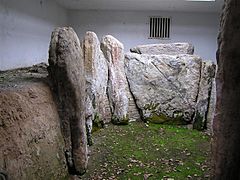Knockmany Passage Tomb facts for kids
 |
|
| Location | near Augher, County Tyrone |
|---|---|
| Coordinates | 54°26′51″N 7°9′34″W / 54.44750°N 7.15944°W |
| Type | Passage tomb |
| History | |
| Periods | Neolithic |
The Knockmany passage tomb, also known as Anya's Cove, is a very old burial place. You can find it on top of Knockmany Hill, near Augher in County Tyrone, Northern Ireland. It's a special type of ancient grave called a passage tomb. This means it has a long stone passage leading to a burial chamber.
It was built a super long time ago, during the Neolithic period. That's about 5,000 years ago! What makes Knockmany extra special are the rare carvings on its stones. These ancient artworks are called megalithic art. To protect this important site, a concrete building was put over it in 1959. This building looks a bit like the original mound that covered the tomb. You can still see the decorated stones by looking through the entrance gates. It's a protected historical site.
Discovering Knockmany Tomb
This ancient monument is a passage tomb. It was built during the Neolithic period, around 3000 BC. Imagine, that's 5,000 years ago!
The burial chamber was once covered by a large pile of stones and earth. This pile is called a cairn. Today, the big standing stones inside the tomb are still there. These tall stones are called orthostats. They stand between 3 and 7 feet (about 1 to 2 meters) high.
Amazing Ancient Art
Three of these orthostats have amazing carved decorations. These carvings include cool shapes like circles within circles, spirals, and zigzags. This type of ancient artwork is known as megalithic art.
The designs at Knockmany are very similar to the decorated stones found at other famous ancient tombs in Ireland. These include sites like Loughcrew and Newgrange. It shows that people in ancient Ireland shared similar artistic styles.
Legends and Folklore
The name Knockmany comes from an old Irish name, Cnoc mBáine. This means "Báine's hill." Báine was believed to be a supernatural being, perhaps even a goddess. Her name means "whiteness."
Over time, Báine's story became mixed up with another famous goddess named Áine. According to old stories, Queen Báine was the wife of a king named Túathal Techtmar. She was supposedly buried here, in the tomb that once belonged to the earlier Queen Áine.
In Irish folklore, this area was also said to be the home of the famous giant, Fionn mac Cumhaill (Finn McCool). His wife, Oonagh, was also part of these local legends.


